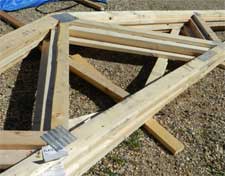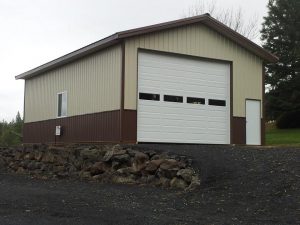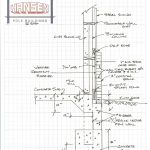Proper storage of trusses at the job site.
Long time readers (or those with time on their hands to have read my previous nearly 1700 articles) will recall in a past life I worked in or owned prefabricated light gauge steel connector plated wood truss manufacturing facilities. In my first long-term position as Sales Manager at Coeur d’Alene Truss (now Coeur d’Alene Builders Supply http://www.cdabuilders.com/) we fabricated huge sets of “saw horses” so we could store trusses vertically in these bunks.
Sadly I see much mishandling of trusses at manufacturing plants, upon delivery and at jobsites. Below are tips to keep your new post frame building’s trusses bright, fresh and structurally sound.
Trusses store best when standing upright.
Shore and brace standing trusses well to keep from toppling. Trusses stored other than in a vertical position can and will warp, and become difficult to use.
Store trusses with “tails” (overhangs) elevated so truss weight rests on the bottom chords, not on the truss tails..
 Unload trusses in bundles and store on level ground, but never in direct contact with ground (to avoid collecting moisture from the ground). Allow for good drainage at truss storage location in the event rain occurs before installation. Protect trusses from damage resulting from on-site activities, environmental conditions or weather. Exercise care at all times to avoid damage to trusses due to careless handling during delivery, unloading, storage, and installation.
Unload trusses in bundles and store on level ground, but never in direct contact with ground (to avoid collecting moisture from the ground). Allow for good drainage at truss storage location in the event rain occurs before installation. Protect trusses from damage resulting from on-site activities, environmental conditions or weather. Exercise care at all times to avoid damage to trusses due to careless handling during delivery, unloading, storage, and installation.
In warm, rainy weather, moisture regain in unprotected trusses can result in fungal staining. Wetting lumber also results in swelling. Subsequent shrinkage may contribute to structural distortions.
To store trusses for a long time period, cover with a water repellent tarp for protection. Plastic is an acceptable alternative, provided there are side openings to allow air flow.
Handle pole building trusses in such a way as to prevent toppling when banding is removed from bundles. Trusses stored on black top (asphalt) or other impervious surfaces and continuously moved around the construction site are subject to damage when they are slid along the surface with equipment. As a result, galvanized coating on connector plates may be removed, allowing plates to rust and possibly reduce plate thickness.










I like your article.. its so true that framing contractors have no clue about storing/blocking trusses once on site.. Question.. What is the defination of “long Term” truss storage in the northeast?? 1 week, 3 week, 2 months??
Thank you for your kind words. On any jobsite of mine, if trusses were not going to be installed within a week, they became long term. When in doubt, error on caution’s side.
Great information. The trusses have been in rainy days in Florida since 25 June 21 and they are moldy. I have I had them tested for mold and should have results in a day or so. They got on site much too soon and blocks started going up today 12 July 21. I have contacted the builder and his straw boss for his crews about covering them once I found out they were going to be here before the blocks. Then we had the storm blow threw here and they are now water logged. I was being told not to worry this is common for Florida, but I disagree. The builder is giving me a song and dance and I don’t dance. If he refuses to remedy the situation, I will call Dept of Professional Regulation nd the Attorney General.
Thank you for your kind words and sorry for your challenge, especially as it was easily preventable. Mold, although unpleasant, can be treated. You will want to make certain trusses have dried out prior to any interior finish being installed.